Modern energy systems’ power demand, durability, and cost are strongly dependent on the efficient design of fuel cell stack design after implementation. PEM fuel cell stack design has continuously evolved by engineers and researchers to develop maximum energy conversion efficiency and to exploit the optimum amount of hydrogen. Knowledge of the principles of fuel cell stack design provides balanced power output, reduction in resistive losses, and improvement in thermal management. As a precision engineering partner, TMNetch offers a unique fuel cell stack design with bipolar plate integration, making advanced components for the design of fuel cell stacks characterized by stable performance suitable for both industrial and research applications.

Fundamental Concepts in Fuel Cell Stack Design
The principles of fuel cell stack design are rooted in how each cell is designed and packaged to operate quickly and efficiently. A single cell typically contains an anode, a cathode, a proton exchange membrane, and is sandwiched between bipolar plates that act as current collectors. This means that the design should harmonize the physical structure with the chemical and electrical properties for the best energy conversion efficiency.
How It Is Designed
Herein, we provide a nomenclature to guide an efficient fuel cell stack design systematically, as well as a discussion of the key technical and structural choices that go into ensuring both efficiency and durability from first principles.
1. Set Power Targets:
The engineers first define the power output, voltage, and current requirements for the specific application. The first of these describes the stack size and has a bearing on the selection of components. In contrast to large stationary stacks, a compact PEM fuel cell stack design for vehicles has unique constraints; defining performance targets ensures the right trade-off between energy density and cost.
2. Determine Cell Count & Size:
The cell count is based on voltage requirements, in that a single cell produces ~0.6–0.8 volts. The active area is subsequently selected based on these current density limits. Principles of fuel cell stack design emphasize current uniformity and flow field geometry to minimize losses.
3. MEA & Catalyst Loading Selection:
The Membrane Electrode Assembly (MEA) is where the magic happens. Engineers decide these factors such as membrane thickness, proton conductivity as well as catalyst mass. However, in an advanced fuel cell stack design for PEM systems both platinum usage and the reaction rates are generally optimized independently to maximize the platinum utilization via maximizing the reaction rates.
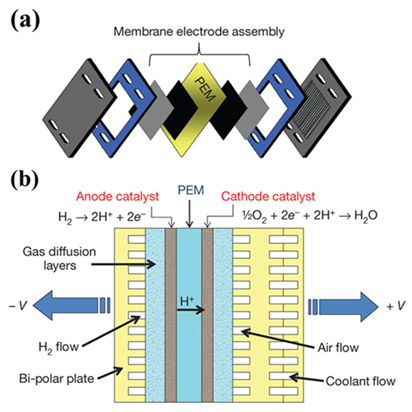
4. Bipolar Plate Material & Process Selection:
Made of graphite, coated stainless steel, or composites. Common options include:
- Graphite Plates: For Long-Lasting, Electrically Conductive, Corrosion-Resistant
- Coated Stainless Steel: This is quite low-cost and durable; therefore, it is also widely used in PEM fuel cell stack design.
- Titanium: Well-suited for an advanced fuel cell stack design for PEM systems requiring superior corrosion protection, lightweight, and strong designer material.
- Carbon-polymer materials: Optimal specific strength, enabling fuel cell stack design with bipolar plate integration
- Nickel-Based Alloys: Nickel alloys find usage in high-temperature systems wherein an increased toughness against oxidation could be required. For the method of fuel cell stack design with bipolar plate integration, the gas channels are machined/ molded in individual plates to direct the gas flow and to provide a constant pressure.
TMNetch provides precision-engineered etched bipolar plates designed for high electrical conductivity, excellent corrosion resistance, and long-term stability in demanding fuel cell environments. Each plate is manufactured with micron-level accuracy to ensure optimal fluid dynamics, uniform current distribution, and reliable performance in PEM and other electrochemical systems.
5. Creating Flow Fields:
Flow fields are needed for the uniform distribution of reactants. Depending on application requirements, engineers can model serpentine, parallel, or interdigitated flow patterns. Good design avoids hotspots, and a better fuel cell stack design for improved fuel utilization.
6. Manage Water:
Regulation of humidity keeps the fluid volume steady on the proton exchange membrane. Here, diffusion layers and channels serve to direct the water only to the intended locations during the flow. This delicate balance between drought and flooding is maintained through the principles of fuel cell stack design.
7. Thermal Architecture:
Protection of the MEA with uniform and even distribution of heat. Engineers add cooling plates or channels that transfer heat away quickly. In the design of the PEM fuel cell stack design, there are advanced sensors that monitor temperatures throughout the stack, which supports a more durable design.
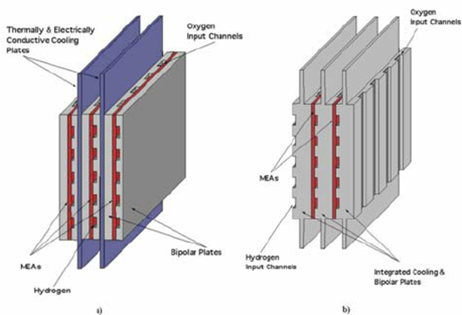
8. Compress & Seal:
End plates and tie rods clamp the stack. We choose your gaskets to minimize and standardize the clearance. It plays a significant role in gas-tight operation with compact fuel cell stack design with bipolar plate integration, which needs to provide stable clamping pressure.
9. Manifolding & Headers:
These manifolds are built to provide an equal distribution of hydrogen and air to each associated cell. These paths are designed to optimize the flow field which is mostly this corresponds to a wide design space in order to limit the magnitude of pressure drop and prevent backflow, while enhancing hydrogen recirculation, the distribution of fuel cell stack design for improved fuel utilization has great significance.
10. Electrical Interconnects & Sensing:
Low-resistance partial structure conductive paths and integrated voltage, temperature, and pressure measuring sensors. This stage provides accurate control over operation and diagnostics in PEM fuel cell stack design.
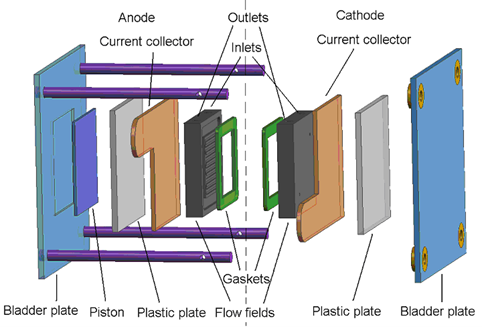
11. Model & Optimize:
Computational Fluid Dynamics (CFD) and Finite Element Analysis (FEA) based simulations of flow, temperature, current density, etc. However, this refinement must occur virtually before production to advanced fuel cell stack design for PEM systems and remain within budget.
12. Construct, Test, Iterate:
The last step is to build prototypes and test their quality. ZFCs are used to detect changes, efficiency maps to locate regions for optimization, and lifetime performance to iterate improvements.
Fuel Cell Stack Design with Bipolar Plate Integration
The integration of the bipolar plate is an important aspect in the fuel cell stack design with bipolar plate integration. These separator and current collector plates have efficient gas directional control, water handling, and heat dissipation capability.
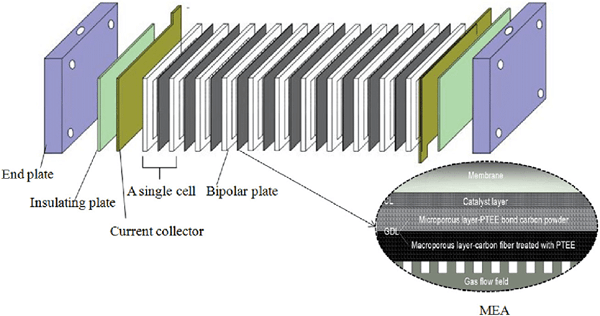
Benefits of Bipolar Plate Integration:
- Improved Long-term Performance: Less leakage between the layers, leading to superior stability of the cells.
- Uniformity: Supports Electrochemical Reactions within the Stack (works for even distribution of reactants).
- Decreased Contact Resistance: Contact is important for the flow of electrons, and hence it is an important area in the design of the PEM fuel cell stack design.
- Improved Thermal Conductivity: Helps in the uniform distribution of temperature amongst all cells.
- Low Weight and Volume: Makes a high power density advanced fuel cell stack design for PEM systems, with better portability and lower material cost.
TMNetch’s etched bipolar plates are engineered for precision and high conductivity. These plates are produced using advanced photochemical etching for fine flow channels that ensure uniform gas distribution, reduced pressure loss, and enhanced durability. Designed for both automotive and stationary applications, they are ideal for PEM fuel cell stack design and long-term reliability. Learn more about the product here: TMNetch Bipolar Plate.
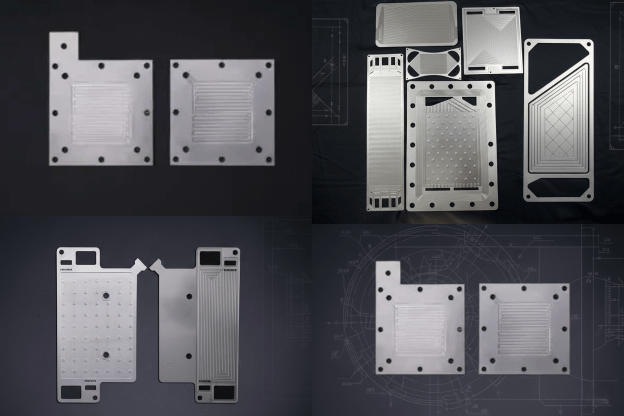
Applications of Fuel Cell Stack Design
Modern fuel cell stack design is applied across different sectors where high efficiency, reliability, and sustainability are critical.
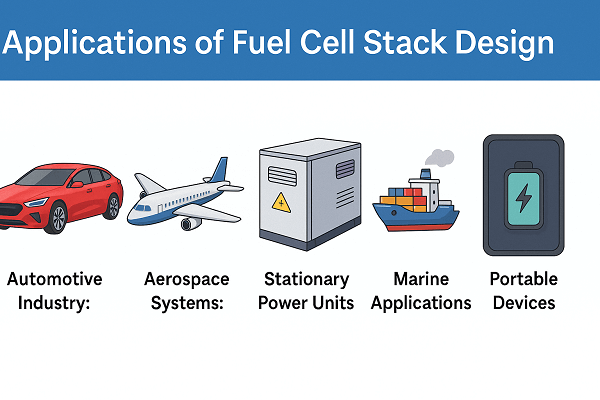
Key Applications:
- Hydrogen Fuel Cell Vehicles: Powering hydrogen fuel cell vehicles with optimized PEM fuel cell stack design.
- Aerospace Systems: Lightweight stacks for Auxiliary Power Systems
- Stationary Power Units: System stationary power units (commercial and residential hosting)
- Marine Applications: Sustainable propulsion of fuel cell stack design for better fuel efficiency for marine applications
- Mobile stacks: Stacks for portable devices and for off-grid applications.
FAQs
Q1. What Are The Major Parts Of A Fuel Cell Stack?
So, essentially, a fuel cell stack is composed of the membrane electrode assembly (MEA), bipolar plates , gaskets, and current collectors. This means that they can help to ensure rapid, manufactured-to-form design of the fuel cell stack and energy conversion associated with the porous fuel cell stack.
Q2. How does a PEM fuel cell stack work?
With no combustion involved, a PEM fuel cell stack design converts hydrogen and oxygen into electricity through electrochemical reactions, with water and heat as the only byproducts.
Q3. What are some of the usual challenges in designing a fuel cell stack?
Those come with their own challenges, humidity, gas leaks, thermal stability, etc, cetera. PEM systems overcome these problems with an advanced fuel cell stack design for PEM systems, state-of-the-art materials, and cooling strategies.
Summary
A fuel cell stack design that maximizes output is also likely to show improved durability, thermal balancing, and overall efficiency. It uses a combination of science, advanced engineering, and modern materials to deliver very high energy output with lower losses. The TMNetch is leading innovation in this area, with PEM fuel cell stack design expertise, fuel cell stack design with bipolar plate integration, and advanced fuel cell stack design for PEM systems. With a commitment to research and technology above all else, they assure a repeatable performance and sustainability, in every project, reliable and cost-effective.
